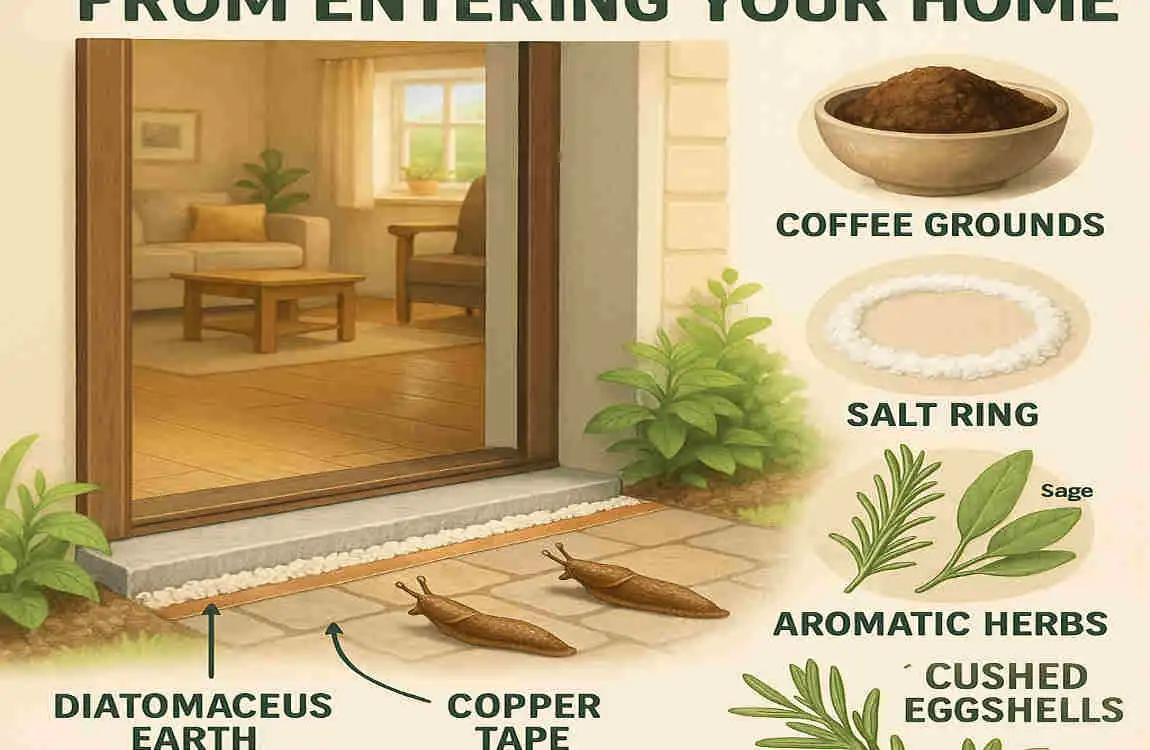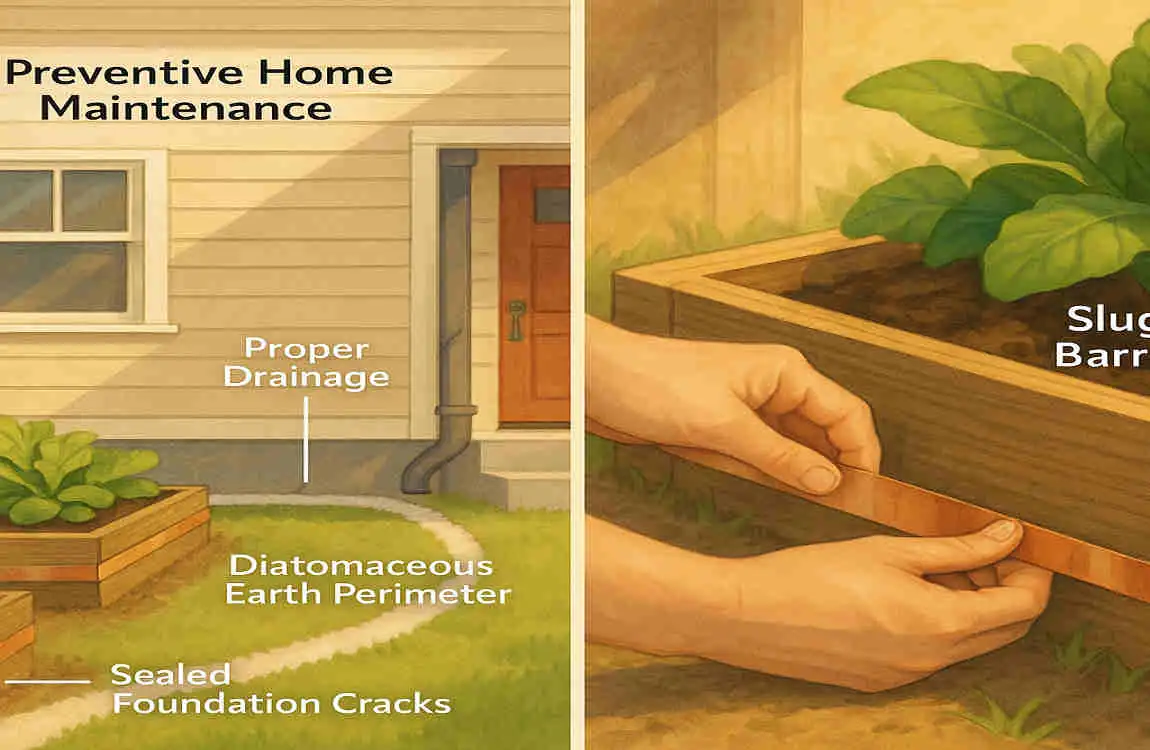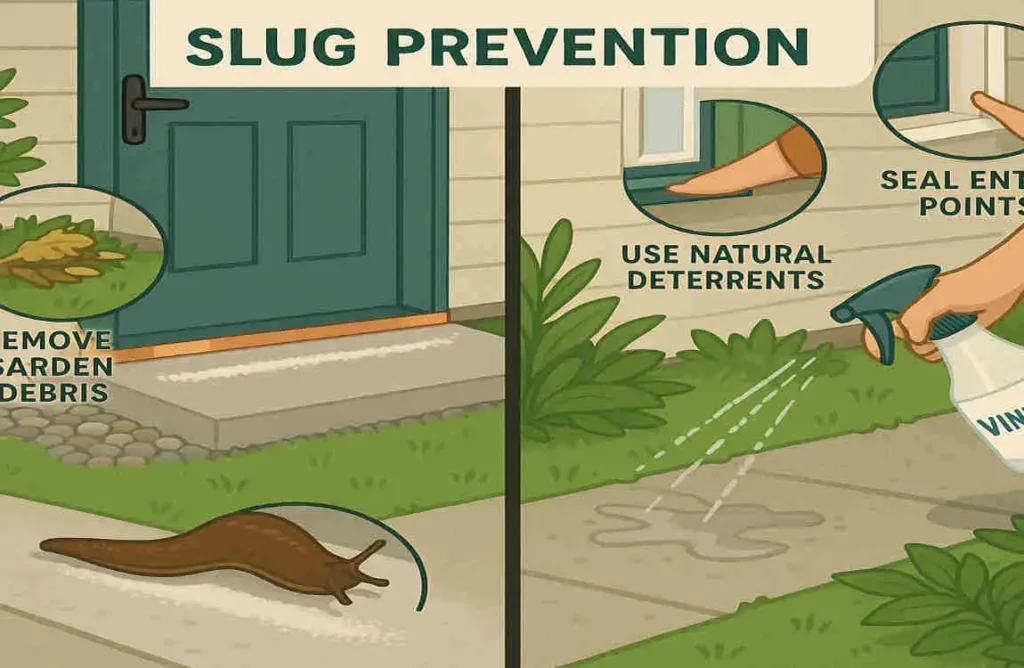Have you ever walked into your kitchen in the morning, only to find a slimy trail leading from the door to your fruit bowl? Or have you noticed mysterious holes in your indoor plants? If so, you might be dealing with a slug invasion. These pesky critters can find their way into your home, causing damage and discomfort. But don’t worry, we’re here to help you learn how to stop slugs from coming into your house through cleaning and other preventive measures.
We’ll cover essential cleaning tips, home maintenance strategies, and additional prevention techniques to create a slug-free environment. So, let’s get started on your journey to a slug-free home!
Understanding Slugs and Their Behavior

What Are Slugs and Why Do They Invade Homes?
Slugs are soft-bodied, shell-less gastropods that thrive in moist environments. They’re attracted to damp, dark, and cluttered areas, making your home a potential haven for them. Slugs invade homes in search of food, shelter, and moisture, often entering through small cracks and gaps.
Common Entry Points and Habitats
Slugs can enter your home through various points, such as:
- Cracks in walls and foundations
- Gaps around doors and windows
- Vents and pipes
- Openings in the roof or chimney
Once inside, they may seek refuge in:
- Basements and crawl spaces
- Bathrooms and kitchens
- Under sinks and appliances
- In potted plants or gardens
Why Slugs Are Attracted to Damp, Dark, and Cluttered Areas
Slugs thrive in environments that provide them with the three essentials: moisture, shelter, and food. Damp areas, such as basements and bathrooms, offer the perfect humidity levels, while dark corners and cluttered spaces provide ample hiding spots. Additionally, slugs are drawn to organic matter, such as food crumbs and plant debris, which they can feed on.
The Role of Cleaning and Home Environment in Slug Prevention
Keeping your home clean and well-maintained is crucial in preventing slug invasions. Regular cleaning removes potential food sources and disrupts the moist, dark environments that slugs crave. By addressing the root causes of slug attraction, you can create an inhospitable environment that discourages them from entering your home.
Signs You Have a Slug Problem
Visual Indicators in and Around Your Home
The most obvious sign of a slug infestation is the presence of the slugs themselves. You may spot them crawling on walls, floors, or in your garden. Additionally, look for:
- Slime trails: Shiny, silvery trails left behind by slugs as they move
- Droppings: Small, dark fecal pellets left by slugs
Damage to Plants, Furniture, and Walls
Slugs can cause significant damage to your indoor and outdoor plants, leaving behind irregular holes and ragged edges on leaves. They may also feed on wooden furniture, leaving behind unsightly marks. In severe cases, slugs can even damage walls by leaving behind corrosive slime trails.
How to Identify Slug Activity Early to Act Fast
Regularly inspecting your home and garden for signs of slug activity is key to early detection and prevention. Check for slime trails, droppings, and plant damage, especially in damp areas. By catching a slug problem early, you can take swift action to address the issue before it worsens.
How Do You Stop Slugs From Coming into Your House? Cleaning: Essential Cleaning Tips
Importance of Regular Cleaning in Stopping Slugs
Regular cleaning is your first line of defense against slugs. By removing potential food sources and disrupting their preferred environments, you can make your home less attractive to these pests. Consistent cleaning also allows you to spot and address any slug activity early on.
Step-by-Step Guide on Effective Indoor Cleaning Strategies
To effectively clean your home and deter slugs, follow these steps:
Declutter Damp Areas
Start by decluttering damp areas, such as basements, bathrooms, and kitchens. Remove any items that create dark, moist hiding spots for slugs, such as old boxes, newspapers, or piles of laundry.
Thoroughly Clean Moisture-Prone Spots
Pay special attention to areas prone to moisture, such as under sinks, around pipes, and in corners. Use a vacuum or broom to remove any debris, then wipe down surfaces with a damp cloth.
Use Vinegar or Soapy Water to Wipe Surfaces
For an extra layer of protection, wipe down surfaces where you’ve seen slugs with a solution of equal parts water and vinegar or a few drops of dish soap mixed with water. These natural cleaners can help deter slugs and remove any slime trails they leave behind.
Remove Food Crumbs and Residues Promptly
Slugs are attracted to food, so it’s essential to clean up any crumbs or residues promptly. Wipe down countertops, sweep floors, and empty trash cans regularly to remove potential sources of food.
Cleaning Outdoors Near Doors and Windows
Don’t forget to clean the areas outside your home, especially near doors and windows. Remove any debris, leaves, or plant matter that could attract slugs. Use a broom or leaf blower to keep these areas clear and less inviting to slugs.
Recommended Cleaning Products and Natural Alternatives
When it comes to cleaning products, opt for natural alternatives that are safe for pets and children. Vinegar, baking soda, and soapy water are all effective at deterring slugs and removing their slime trails. If you prefer commercial products, look for eco-friendly, non-toxic options.
Preventive Home Maintenance Measures for a Slug-Free House

How to Seal and Block Slug Entry Points
Sealing and blocking potential entry points is crucial in preventing slugs from entering your home. Inspect your walls, foundation, and vents for any cracks or gaps, and repair them using caulk or weather stripping as needed. Install door sweeps and weatherproofing seals to create a barrier against slugs.
Proper Drainage and Moisture Control
Proper drainage and moisture control around your home’s exterior can help deter slugs. Ensure that gutters and downspouts are clear and functioning properly to direct water away from your home’s foundation. Fix any leaks or moisture issues promptly to create a less inviting environment for slugs.
Landscaping Tips to Make Your Garden Less Slug-Friendly
Your garden can be a magnet for slugs, so it’s essential to make it less attractive to them. Remove dense foliage and debris near your home’s walls, as these provide ideal hiding spots for slugs. Avoid overwatering your plants, as excess moisture can attract slugs. Consider planting slug-repellent plants, such as lavender, rosemary, or sage, to deter slugs from your garden.
Using Barriers to Deter Slug Movement
Creating physical barriers can help prevent slugs from entering your home. Consider using:
- Copper tape: Slugs dislike the electrical charge that copper emits, making it an effective barrier against them.
- Diatomaceous earth: This powdery substance can dehydrate and kill slugs when they crawl over it.
- Gravel or crushed eggshells: These rough surfaces can deter slugs from crossing them.
Additional Prevention Techniques Beyond Cleaning
Natural Slug Repellents
In addition to cleaning and home maintenance, you can use natural slug repellents to further deter these pests. Some effective options include:
- Garlic spray: Mix crushed garlic with water and spray it around the perimeter of your home.
- Coffee grounds: Slugs dislike the smell and texture of coffee grounds, making them a useful deterrent against these pests.
- Salt: While salt can kill slugs, use it sparingly and only in areas where you don’t want plants to grow, as it can harm vegetation.
Using Slug Traps
Slug traps can help you monitor and control populations of slugs. Some effective trap options include:
- Beer traps: Bury a shallow container filled with beer in your garden; slugs will be attracted to the yeast and drown.
- Eggshell traps: Place crushed eggshells in a shallow dish; slugs will be drawn to the calcium and get trapped.
Beneficial Predators and Biological Control
Introducing beneficial predators can help control slug populations naturally. Some options include:
- Ducks: These birds love to eat slugs and can help keep your garden slug-free.
- Nematodes: These microscopic worms can be applied to your garden to kill slug larvae.
- Toads: These amphibians are natural predators of slugs and can help control their populations.
Chemical Slug Baits
If natural methods aren’t effective, consider using chemical slug baits. However, use these products with caution, as they can be harmful to pets, children, and beneficial wildlife. Always follow the manufacturer’s instructions and apply baits only in areas where you don’t want plants to grow.
Creating a Slug Prevention Routine
Combining Cleaning with Preventive Maintenance
To maintain a slug-free home, it’s essential to combine regular cleaning with preventive maintenance. Create a routine that includes:
- Weekly cleaning of damp areas and potential slug habitats
- Monthly inspections of your home’s exterior for cracks and gaps
- Seasonal maintenance of your garden and landscaping
Suggested Weekly and Monthly Checklists
To help you stay on track, here are some suggested weekly and monthly checklists:
Weekly Checklist
- Vacuum or sweep floors, especially in damp areas
- Wipe down countertops and remove food crumbs
- Check for and remove any slug sightings
- Inspect indoor plants for signs of slug damage
Monthly Checklist
- Inspect your home’s exterior for cracks and gaps
- Clean gutters and downspouts
- Remove debris and dense foliage from your garden
- Check and replace any slug barriers or traps
Seasonal Tips
As the seasons change, so do slug populations. Prepare for wetter months when slugs are more active by:
- Sealing any cracks or gaps in your home’s exterior
- Ensuring proper drainage around your home’s foundation
- Applying slug repellents or barriers around your garden
- Regularly inspecting your home and garden for signs of slug activity
How Regular Inspection Prevents Reinfestation
Regular inspection is key to preventing slug reinfestation. By catching any signs of slug activity early, you can take swift action to address the issue before it worsens. Make it a habit to regularly inspect your home and garden for signs of slime trails, droppings, and plant damage.
Common Mistakes to Avoid When Trying to Stop Slugs
Ignoring Yard Maintenance and Outdoor Cleaning
One of the biggest mistakes people make when trying to stop slugs is neglecting their yard maintenance and outdoor cleaning. Remember, slugs can easily travel from your garden to your home, so keeping your outdoor spaces clean and less inviting is crucial.
Overwatering Plants Near the Home
Overwatering your plants, especially those near your home, can create a perfect environment for slugs. Be mindful of your watering habits and ensure that your plants have proper drainage to avoid excess moisture.
Using Harmful Chemicals Improperly
If you choose to use chemical slug baits, follow the manufacturer’s instructions carefully. Using these products improperly can harm pets, children, and beneficial wildlife, so always prioritize safety.
Not Sealing Entry Points Effectively
Failing to seal and block slug entry points effectively is another common mistake. Take the time to thoroughly inspect your home’s exterior and repair any cracks or gaps to create a strong barrier against slugs.
